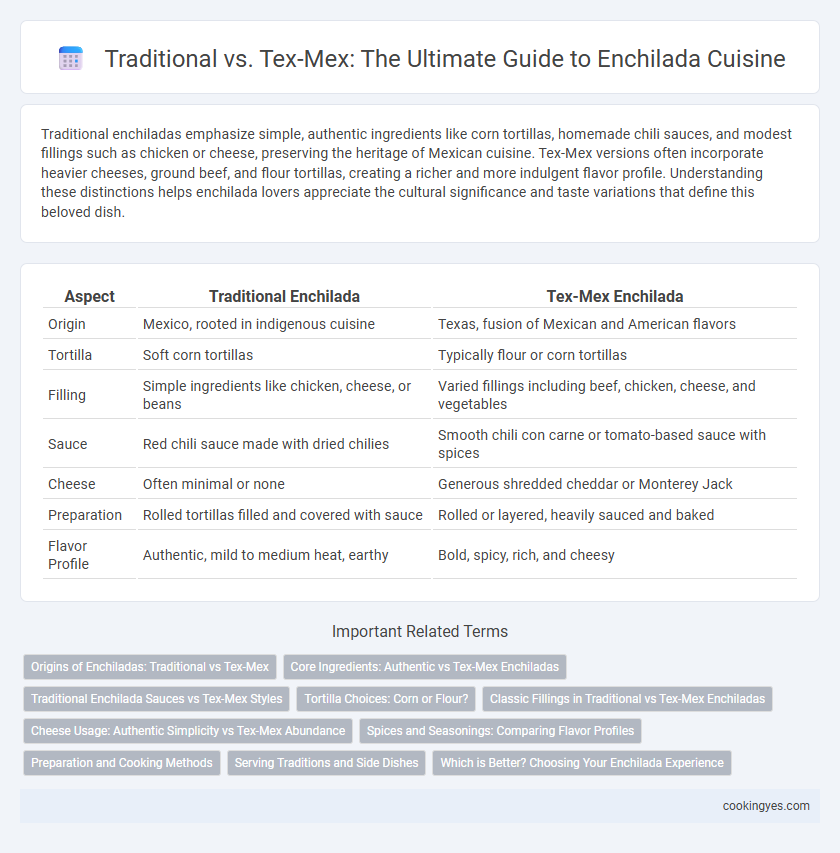Traditional enchiladas emphasize simple, authentic ingredients like corn tortillas, homemade chili sauces, and modest fillings such as chicken or cheese, preserving the heritage of Mexican cuisine. Tex-Mex versions often incorporate heavier cheeses, ground beef, and flour tortillas, creating a richer and more indulgent flavor profile. Understanding these distinctions helps enchilada lovers appreciate the cultural significance and taste variations that define this beloved dish.
Table of Comparison
| Aspect | Traditional Enchilada | Tex-Mex Enchilada |
|---|---|---|
| Origin | Mexico, rooted in indigenous cuisine | Texas, fusion of Mexican and American flavors |
| Tortilla | Soft corn tortillas | Typically flour or corn tortillas |
| Filling | Simple ingredients like chicken, cheese, or beans | Varied fillings including beef, chicken, cheese, and vegetables |
| Sauce | Red chili sauce made with dried chilies | Smooth chili con carne or tomato-based sauce with spices |
| Cheese | Often minimal or none | Generous shredded cheddar or Monterey Jack |
| Preparation | Rolled tortillas filled and covered with sauce | Rolled or layered, heavily sauced and baked |
| Flavor Profile | Authentic, mild to medium heat, earthy | Bold, spicy, rich, and cheesy |
Origins of Enchiladas: Traditional vs Tex-Mex
Enchiladas originate from traditional Mexican cuisine, featuring corn tortillas filled with simple ingredients like chicken or cheese, topped with chili-based sauces rooted in indigenous culinary practices. Tex-Mex enchiladas evolved in the American Southwest, blending Mexican flavors with American ingredients, often incorporating beef, cheddar cheese, and flavorful chili con carne sauces. The contrast in origins highlights traditional enchiladas' focus on authentic Mexican heritage, while Tex-Mex enchiladas reflect a fusion influenced by diverse regional tastes.
Core Ingredients: Authentic vs Tex-Mex Enchiladas
Authentic enchiladas use corn tortillas, homemade red or green chili sauces, and simple fillings like shredded chicken or cheese, emphasizing fresh, regional ingredients and balanced flavors. Tex-Mex enchiladas often incorporate flour tortillas, processed cheese, ground beef, and enchilada sauce mixes, resulting in richer and heavier dishes with bold, salty profiles. The core ingredient differences between authentic and Tex-Mex enchiladas highlight the contrast between traditional Mexican culinary techniques and Americanized adaptations.
Traditional Enchilada Sauces vs Tex-Mex Styles
Traditional enchilada sauces emphasize rich, complex flavors crafted from dried chili peppers like ancho, guajillo, and pasilla, often blended with spices, garlic, and tomatoes to create a deep, authentic red sauce. Tex-Mex enchiladas typically use a smoother, milder chili sauce with a tomato base, sometimes incorporating ground meat and cheese to appeal to broader American tastes. The texture and spiciness of traditional sauces offer a distinct contrast to the often sweeter and creamier Tex-Mex varieties, highlighting regional culinary adaptations.
Tortilla Choices: Corn or Flour?
Traditional enchiladas typically use corn tortillas, prized for their authentic texture and ability to absorb rich chili sauces without becoming soggy. In Tex-Mex cuisine, flour tortillas are often favored for their soft, pliable nature and milder flavor, which complements heavier fillings and cheese. Understanding the distinction between corn and flour tortillas is essential for appreciating the regional variations and flavor profiles in enchilada dishes.
Classic Fillings in Traditional vs Tex-Mex Enchiladas
Traditional enchiladas feature fillings such as shredded chicken, cheese, and mild chili sauces, emphasizing authentic Mexican flavors like mole or salsa verde. Tex-Mex enchiladas incorporate ground beef, cheddar cheese, and robust, spiced red chili sauces, blending American ingredients with Mexican inspiration. Classic fillings reflect the cultural distinctions, with traditional recipes showcasing simplicity and regional produce, while Tex-Mex versions highlight heartier, more heavily seasoned components.
Cheese Usage: Authentic Simplicity vs Tex-Mex Abundance
Traditional enchiladas emphasize authentic simplicity with modest cheese usage, typically featuring queso fresco or a light sprinkle of white cheese to complement the rich chili sauce and fresh ingredients. Tex-Mex enchiladas showcase an abundant amount of melted cheddar or Monterey Jack cheese, creating a richer, creamier texture that caters to bold flavor preferences. This contrast highlights the cultural distinctions between Mexican culinary heritage and Tex-Mex fusion, where cheese quantity and type define the overall enchilada experience.
Spices and Seasonings: Comparing Flavor Profiles
Traditional enchiladas feature rich, smoky flavors from dried chili powders such as guajillo, ancho, and pasilla, combined with garlic, cumin, and oregano to create a deep, earthy profile. Tex-Mex enchiladas often incorporate chili powder blends with a sweeter, milder heat, enriched by cumin and sometimes chili sauce or commercial seasoning mixes, resulting in a more robust and tangy taste. These differences in spices and seasonings highlight the authentic regional flavor distinctions between traditional Mexican and Tex-Mex enchilada styles.
Preparation and Cooking Methods
Traditional enchiladas emphasize homemade corn tortillas filled with simple, fresh ingredients like shredded chicken, cheese, or beans, often smothered in a rich, smooth chili sauce made from dried chilies. Tex-Mex enchiladas typically feature flour tortillas, a combination of ground beef or shredded meat, and a more robust, sometimes cheese-heavy sauce, cooked with melted cheddar or processed cheese blends. Preparation in traditional enchiladas involves simmering sauces and baking the rolled tortillas gently, while Tex-Mex styles often bake enchiladas covered with cheese for a gooey, golden crust.
Serving Traditions and Side Dishes
Traditional enchiladas are typically served with red or green chili sauce and accompanied by simple side dishes like refried beans and Spanish rice, emphasizing authentic Mexican flavors. Tex-Mex enchiladas often feature melted cheese, ground beef, and a thicker, spicier sauce, paired with sides such as tortilla chips, guacamole, and nacho-style toppings. Serving traditions in traditional cuisine prioritize corn tortillas and minimal garnishes, while Tex-Mex enchiladas incorporate flour tortillas and heavier, more varied accompaniments.
Which is Better? Choosing Your Enchilada Experience
Traditional enchiladas highlight handmade corn tortillas filled with simple ingredients like chicken, cheese, or beans, topped with a robust red or green chili sauce, emphasizing authentic Mexican flavors. Tex-Mex enchiladas incorporate flour tortillas, ground beef, and a richer, often cheese-heavy sauce, appealing to those who prefer bold, hearty tastes. Choosing between the two depends on whether you prioritize genuine cultural authenticity or a richer, more indulgent flavor profile in your enchilada experience.
Traditional vs Tex-Mex for Enchilada cuisine Infographic

 cookingyes.com
cookingyes.com